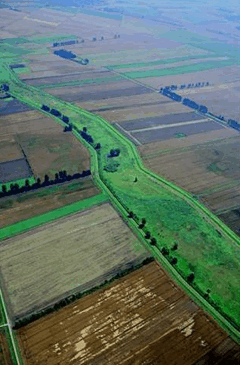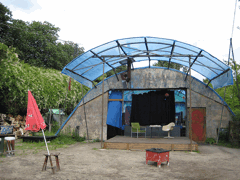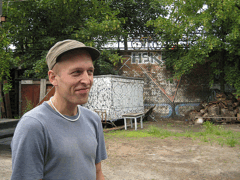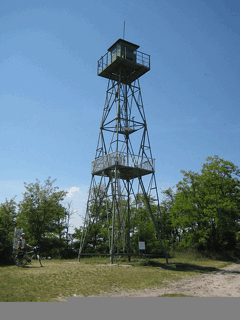Squatting the Berlin Wall
Air Date: Week of November 6, 2009

The Iron Curtain left behind an accidental strip of wilderness between Eastern and Western Europe. (photo: IUCN)
November 9 marks the 20th year anniversary of the fall of the Berlin Wall, which split the city of Berlin between Communist and capitalist control during the Cold War. Soon after the wall came down, a group of squatters moved into the barren wasteland and has been working to green the buffer zone ever since. As Ashley Ahearn reports, they may also provide a model for sustainable urban living today. Host Jeff Young follows up with Ashley about some of the stories she heard while reporting from behind the green curtain.
Transcript
YOUNG: Twenty years ago this week the Berlin wall was coming down – reuniting Eastern and Western Germans after almost 30 years. German Chancellor Angela Merkel marked the anniversary with a speech to the U.S. Congress. Merkel urged action to make a climate change agreement at Copenhagen possible. She called inaction another wall that must be brought down.
MERKEL: Once we in Europe and America show ourselves ready to adopt binding agreements we will also be able to persuade China and India to join in. And then in Copenhagen we shall be able to overcome this wall separating the present from the future in the interest of our children and grandchildren and in the interest of sustainable development all over the world. (APPLAUSE)
YOUNG: Today, parts of the former no man’s land along the iron curtain have come back to life in unexpected ways. Ashley Ahearn visited one community, nestled into the former militarized zone of the Berlin Wall, where people are redefining sustainable urban living.
[BOB MARLEY MUSIC PLAYING IN BACKGROUND, PEOPLE TALKING]
AHEARN: If you walk the former path of the Berlin Wall south from the Brandenburg Gate, you’ll come across a gravel footpath on the banks of the Landwehr canal.
Pumping music will lead you under a bridge and around a wooded corner and you’ll find, tucked in amongst lush greenery, the squatter community of Lohmuhle. But it’s not just any squatter community.
EWING: I think squatting always has been, the aspect of taking care of the place and not just going in there and say okay, we’ll be here for a bit until the roof comes down and then we’ll squat something else.

The stage in the center of the Lohmule trailer community in Berlin is a forum for education about sustainable low impact urban living. (photo: Ashley Ahearn)
AHEARN: Piers Ewing stands near a large dome-shaped structure made of plywood and particleboard. Two old deck chairs sit on a small stage. Behind them a bedraggled black theater curtain shields the entrance to the building. Off to the right of the stage is a makeshift bar. It’s made of particleboard decked with palm leaves and thatched reeds, Caribbean-style. A DJ spins records as Berliners talk and laugh in battered lawn chairs nearby. A couple of kids play in the grass.
[MUSIC FADES UP AGAIN, KIDS TALKING OVER IT]
EWING: It used to be a greenhouse in its former life and was built into a multi-use sort of stage and café building. So we are one of the few trailer parks that actually do things all year through.
AHEARN: By “doing things”, Piers means the public music, theater and education projects that take place on the old greenhouse-turned stage behind him. This community is more than a residential trailer park.
Since 1991 the squatters of Lohmule have worked to bring this dead strip along the Berlin Wall back to life. The city of Berlin has granted the squatters a permit to stay here because they are improving the landscape while educating the public about low-impact living. Piers lives here with 18 other people. They work as artists, teachers, shopkeepers, bike messengers and even clowns. Everyone uses an outhouse, where they rely on microorganisms to reduce the smell and help break down the waste.
EWING: No one knows what they are actually doing but apparently they are doing a good job.

The Iron Curtain left behind an accidental strip of wilderness between Eastern and Western Europe. (photo: IUCN)
AHEARN: The squatters carry water in buckets from the nearby canal to water their vegetable garden, which is tucked in amongst the 15 or so trailers out behind the stage area. Piers has installed solar panels on most of the trailers, making Lohmule almost completely energy independent. They power the stage and café area with a generator but there are plans to get a windmill installed soon. Anna Grichting is an architect who has been studying planning and sustainable development in Berlin since the wall came down.
GRICHTING: This space used to be totally barren sand with weed killers and now nature has reclaimed this space and what their experiment is to cooperate with nature.
AHEARN: Grichting studies boundary areas all over the world, focusing mainly on the demilitarized zone in Korea, the Green Line in Cyprus and the Berlin Wall. She sees this community as a prime example of how people repurpose the no man’s lands created by international conflict.
GRICHTING: It’s interesting because it’s a laboratory of ecological planning in these in between spaces. And I think it’s not only from the nature but also these new communities or new ways of living that emerge from these spaces.
AHEARN: Piers Ewing doesn’t see himself as a lab rat, or even an ecological planner. But he agrees that without the Berlin Wall, there could never have been a place like Lohmuhle. In the chaos that followed the wall coming down, the government didn’t have the resources to squelch the creative energy that spawned this community.
EWING: With the fall of the wall there was so much space and even if they didn’t like it they just couldn’t keep up with like getting everything paved and building fancy new places. It just couldn’t keep up so it was pretty easy to get things going and get a long-term perspective. Yeah it’s getting harder but it’s still Berlin and it’s not London or Paris or someplace like this.
AHEARN: For Ewing, Lohmuhle is a patch of wildness in the urban environment, but it also represents a unique opportunity to live life a little bit on the wild side, outside of the rat race. He studied physics in college but for now Piers is happy teaching drums in the local community, and working on his own musical projects.
EWING: If I put it on a financial scale, but I don’t want to, I would be better off working a bit more and moving into a flat. I would have more time or more money in the end, but if I work on the project, I decide what I do, and not my boss.

Piers Ewing has lived in Lohmule for about two years now, and installed solar panels on almost every trailer. The community is almost energy independent. (photo: Ashley Ahearn)
AHEARN: Ewing’s too young to really remember what life was like when his country was divided by the wall and the Cold War, but whether he understands it or not, he’s part of the healing process for the city of Berlin. Among all the grand public buildings that have sprung up where the wall once split the city – Lohmuhle represents an alternative approach to rebuilding after troubled times, and a new take on modern urban life.
YOUNG: Ashley Ahearn’s reporting was made possible by a grant from the Institute for Human Sciences in Vienna. Ashley spent the summer traveling sections of the former iron curtain, now she’s back in the states and with us in the studio. Welcome back, Ashley.
AHEARN: Thank you, Jeff.
YOUNG: You know, I’m amazed by these examples you found. I guess you might call these accidental conservation areas all along the old iron curtain?
AHEARN: They really were – they’re not planned. It was a complete function of the dark history of the period. As one professor explained it me, you know, all walls represent policy failed, and this was really an instance where nature profited from that failure in policy. This was unused land.
YOUNG: Went into the vacuum, if you will.
AHEARN: Yeah.
YOUNG: And in some spots, it’s almost like the no-mans-land there of the iron curtain became kind of the last hedgerow for animals seeking shelter from the development on either side.
AHEARN: Yeah, it was an idea that I think a lot of Americans – or, at least I had a really hard time wrapping my head around – that people really couldn’t travel to the other side of this curtain, it really was a curtain of iron. It was about a 50 meter to 100 meter wide militarized buffer zone that people weren’t allowed to pass. It had guard towers, watchdogs, land mines – I mean, it was a really – they weren’t messing around.

Towers that once served as vantage points from which to shoot refugees from Eastern to Western Europe now serve as bird observation towers in Neusiedler Seewinkel Park on the border between Austria and Hungary. (photo: Ashley Ahearn)
YOUNG: Well, tell me about some of the places and people you visited along the way? Tell me about Kai Frobel – he sounds interesting.
AHEARN: [laughs] Yeah, Kai Frobel’s really an amazing man. I guess I describe him to people as a cross between the Dr. Seuss character the Lorax and David the gnome. He’s just a very, very committed birder, and he’s been watching birds since well before the iron curtain came down. He grew up in a little town in northeastern Bavaria, right on the iron curtain; you could see it from his village.
And he spent his days, his afternoons, or early mornings, as it were, with binoculars walking along the militarized border. And the border police came to know him. However, the East Germans had a file about an inch thick on him because they thought he was a spy. Here he is, he’s out here with his binoculars and his little green jacket, camouflage gear, the whole deal.
YOUNG: Sure you’re looking at bird, buddy…
AHEARN: [laughs] Yeah, right. But, Kai, he really was. He was just in it for the birds. He cared really deeply, he was counting populations and really figuring out that they were taking refuge in this place that was surrounded by wheat fields on either side, so it was important habitat. And he’s the one who ended up starting the greenbelt movement. He realized what he was seeing in his outside, his own little village, was happening all up and down the iron curtain, and this was a huge opportunity for conservation.
YOUNG: Wow.
AHEARN: Yeah, he is such an unassuming man, but he held a small, informal meeting right in 1989 after wall came down, and invited some friends from East Germany and West Germany, trying to bring these people together – 200 people showed up. And ever since then this movement has just taken off.
YOUNG: What do they think might become of this? Are they going to be able to link up sections along the old iron curtain?
AHEARN: They’re kind of looking at it not as creating a new, green curtain – that’s not the goal, and a lot of people are nervous about that, they don’t want to see this blocked off. They don’t want a new division from eastern and western Europe. Kai Frobel talks about it as a green necklace, really, where you were given this wonderful opportunity with these chunks of green spaces along the former iron curtain. Why not try to create almost a very thin Appalachian Trail type idea, that would connect these chunks, like jewels in a necklace.
YOUNG: And in some places it really is taking off, the Harz National Park in Germany you visited there. Wolves are actually making a comeback.
AHEARN: Yeah. This is an amazing place; it’s kind of north-central Germany, mountainous area – well, not big mountains, but a really beautiful green patch in a pretty developed part of Germany. And Goethe made this place famous when he wrote about Walpurgisnacht, where all the riches come from all around the world and they gather in this one mountain, the Brokken, and they have a celebration with the Devil. And it was left wild, nobody was using this space, nobody was allowed to use this space. And so, now that the wall of the iron curtain has come down, you’re left with this green space and the wolves are moving in from Poland, from eastern Germany, and starting to kind of populate what they’re trying to keep as a green space now. And of course it’s raising all sorts of controversy, just like it does here in the U.S.
YOUNG: You also visited Lake Neusiedl, this is on the border between Austria and Hungary. And I just love the sort of swords into plow shares imagery here, where the old guard watchtower – people now use it for bird watching.
AHEARN: Yes, Alois Lang, who is a coordinator for the park took me up on one of these things with all my recording equipment and it was a very, very nerve-racking thing, not being a big fan of heights myself. But these towers, really, I mean you can see exactly why they had them in. The lake is only about three feet deep, it’s surrounded by reed beds, which makes it a great spot for birds, that use it as a migratory – major migratory stopover – from Africa to the Arctic. But it was also a great way to escape from Hungary into Austria, and so you have people trying to come across this very shallow lake, and people from these guard towers would shoot them.
YOUNG: Do people visiting these places for the great nature – do they still get a sense of this very dark episode in human history, even though they’re there for the natural history?
AHEARN: I think people only want a certain dose of dark history, I think when you’re on a family vacation you don’t want to be talking about people getting shot from guard towers, but I think for Austrians, for Germans, this is a really important part of their history. And so being able to put a green light on it, a sort happier light on it, is a great way to kind of have your spoonful of sugar with your historical medicine, as it were.
YOUNG: Ashley Ahearn telling us about nature’s comeback along the old iron curtain. Thanks a lot, Ashley.
AHEARN: Great to be here, Jeff.
Links
Living on Earth wants to hear from you!
Living on Earth
62 Calef Highway, Suite 212
Lee, NH 03861
Telephone: 617-287-4121
E-mail: comments@loe.org
Newsletter [Click here]
Donate to Living on Earth!
Living on Earth is an independent media program and relies entirely on contributions from listeners and institutions supporting public service. Please donate now to preserve an independent environmental voice.
NewsletterLiving on Earth offers a weekly delivery of the show's rundown to your mailbox. Sign up for our newsletter today!
 Sailors For The Sea: Be the change you want to sea.
Sailors For The Sea: Be the change you want to sea.
 The Grantham Foundation for the Protection of the Environment: Committed to protecting and improving the health of the global environment.
The Grantham Foundation for the Protection of the Environment: Committed to protecting and improving the health of the global environment.
 Contribute to Living on Earth and receive, as our gift to you, an archival print of one of Mark Seth Lender's extraordinary wildlife photographs. Follow the link to see Mark's current collection of photographs.
Contribute to Living on Earth and receive, as our gift to you, an archival print of one of Mark Seth Lender's extraordinary wildlife photographs. Follow the link to see Mark's current collection of photographs.
 Buy a signed copy of Mark Seth Lender's book Smeagull the Seagull & support Living on Earth
Buy a signed copy of Mark Seth Lender's book Smeagull the Seagull & support Living on Earth

